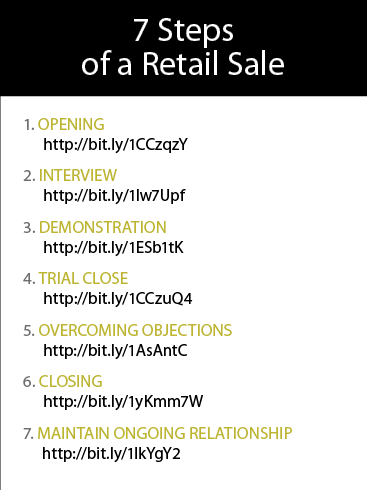Article
7 steps to boost optical revenue
Following specific steps in the retail-selling process will increase the likelihood that customers will make a purchase.
Take-home message: Following specific steps in the retail-selling process will increase the likelihood that customers will make a purchase.
Dispensing Solutions By Arthur De Gennaro

De GennaroOver recent months, readers of this column have been on a journey of sorts, exploring the landscape of the retail-selling process. Readers have learned how there are seven specific parts to a retail sale, and that if these steps are used in order and skillfully executed, the likelihood a customer will make a purchase increases significantly.
Blog: Combatting UPP at the source
The reverse is also true. Rather than recap the articles, which are available online, I’d like to leave some additional thoughts.
Favorite sayings
I have a few favorite sayings. One of them is: “People do business with people they know and like, not people they do not know or like.”
You could also insert the word “trust” into that expression.
Did you know these 7 men were ophthalmologists?
Retailing is a people business. Consumers are naturally drawn to places where they can obtain high levels of knowledgeable, personalized service from caring professionals. That is what is so disturbing about the current rush to dehumanize the retail process through the use of technology. I predict that the pendulum will eventually swing the other way, as consumers find that good, old-fashioned, face-to-face customer service makes all the difference in the retail world.
In witness to this, consider that although online eyewear sales are growing, they are growing much more slowly than other, non-customized products, such as books and clothing. The greatest gains in online eyewear sales are in the non-prescription category. No surprise.
Next: Step 1-Sales training
What to do?

Just talking about knowledgeable, caring service does not “get the job done.” What is needed is a plan. Here are some tactics to consider:
1. Sales training
The obvious question is: What should I do to improve sales in my ophthalmology practice? The first answer is sales training. It is a fact that the substantial majority of opticians have not completed a comprehensive course on retail selling. As this article series has suggested, it would be a mistake for any dispensing ophthalmologist to presume that because an optician has a state license or an ABO certification that he or she knows how to sell.
Should aging doctors be tested for competency?
My experience is to the contrary. Just like any other position in the office, opticians need to be trained how to do their job. Since selling is the number-one behavior that opticians exhibit every day, teaching them how to sell makes very good business sense.
2. Supervision
Supervision is also key. Without adequate, knowledgeable supervision, very few opticians have the ability to focus day after day on the fundamentals of selling and have the discipline to hone their skills so that they are best in class.
Next: Step 3-Compensation
An appropriate supervisor then becomes a “must have.” That supervisor, however, must have access to a set of metrics that tell how successful are the opticians.
I like to see those metrics compared with national averages and best-in-class performances. This allows the supervisor to set goals and deliver appropriate training. After all, there is no need to train someone who is three times the national average in AR sales, when there are team members at half the national average.
3. Compensation
As a recruiter, I can attest to the fact that employers have a tendency to want to pay 50th-percentile wages when hiring. However, this is completely contrary to the search criteria they establish. Generally, they are looking for an optician who has above-average skills. Wanting a high level of skill is understandable. Not wanting to pay for those skills is not.
Practice nets over $1 million from EHR adoption
The reason employers tend not to pay for a “good” optician is because they are afraid of paying for something they may not get. This is also understandable.
The remedy is to push much of the compensation into a bonus or incentive program. As a benchmark, if an optician can perform in the 75th-percentile, he or she should receive 75th-percentile pay. Presuming the workplace is a positive environment, the optician would tend to want to stay for a very long time. This creates the win-win situation most employers and opticians crave.
Next: Step 4-Think outside-in
4. Think Outside-In
Far too many dispensaries and their host ophthalmology practices are inside-out thinkers. The majority of their policies and processes are focused on the needs of the practice instead of the wants of the patient. This way of thinking does not create world-class ophthalmology practices. The remedy is to begin thinking outside in. Some examples:
- Inside-out practices will not special order frame styles and/or colors and sizes that are not in inventory. Outside-in practices will.
- Physicians in inside-out practices do not make appropriate eyewear recommendations to patients. Outside-in practice physicians do.
- Physicians in inside-out practices do not walk appropriate patients to the dispensary and instruct the optician what to patient needs. Outside-in practice physicians do.
- Inside-out practices have warranty and return policies that are rigidly enforced. Outside-in companies have generous policies that are flexible and recognize that not all situations “fit the mold,” so to speak.
- Inside-out practices are focused on policies. Outside-in practices are focused on people and their needs. Those people are patients first, employees second, and physicians (owners) third.
My hope is that this series of articles has proven of interest and that readers will be able to implement much of what they have learned into their dispensing ophthalmology practice over the coming months.
Uncertainty of glaucoma patient accidents easier to discern with new tests
To be continued...
Arthur De Gennaro is president of Arthur De Gennaro & Associates LLC, an ophthalmic practice management firm that specializes in optical dispensary issues. De Gennaro is the author of the book The Dispensing Ophthalmologist. He can be reached at 803/359-7887, arthur@adegennaro.com, or through the company’s Web site, www.adegennaro.com. He maintains a blog at www.adgablog.wordpress.com.
Newsletter
Don’t miss out—get Ophthalmology Times updates on the latest clinical advancements and expert interviews, straight to your inbox.




